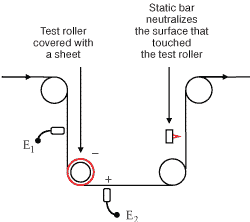Static performance should be evaluated every so often to test its execution abilities. Every product has a process of its own with a distinctive formation. Some of the most important times to evaluate your static performance are when an existing product is being changed or when a new product is being introduced. This is very important and we here at Whitlam Group are dedicated to providing you with as much useful information as we can. We are renowned for high-quality products, primarily because no product leaves our building until they are properly tested. The static performance test is just one of the many quality checks we routinely make on our equipment, but today we want to provide you with a little bit of insight on the matter.
First, take a look below at a practical example taken from the article “How to Measure Charge Performance,” by Kelly Robinson from www.pffc-online.com:
“When high levels of static are measured on a winding roll, we must determine the source of the charging. The following are three possible sources:
- Formulation Static | The unique formulation makes the product more prone to static.
- Process Static | The static neutralizers installed on the film path do not provide satisfactory static control. The neutralizers should be moved to more effective locations.
- Hot Roll | The incoming roll as received had high static from previous operations.
We need good measurements to guide our decisions. Figure 1 shows one way to measure static charging performance using a sheet of new product. To develop a procedure for measuring the static charging performance, you and your team can start with this procedure and modify it so it works in your operation.
- Select an idler roller in your operation as the test roller.
- The test roller should have a film wrap of at least 90 deg.
- The roller should have easy access for cleaning.
- It must be easy to take fieldmeter measurements on the film spans before and after the roller.
- There should be a downstream static bar neutralizing the film surface that touches the test roller.
- Tape a sheet of the new film around the test roller when the line is down.
- Start running and dedicate about a minute of run time to make the fieldmeter measurements on the film spans before and after the test roller.
- Check the zero on your fieldmeter by measuring the field on a grounded roller or on the machine frame.
- The difference in fieldmeter reading (E2 – E1) measures the static on the film from touching the sheet taped to the test roller.
- Stop running and remove the film sheet from the test roller. Carefully clean the roller to remove all tape adhesive.
- Start running and resume normal operations.”
Now that you have discovered a way to measure your static charging performance, you need to assess the proper materials for your operation. Finding out the charging performance of numerous materials greatly increases your chances of making the right decisions about new product formulation.
Once you have measured the static charging, you’ll have a better idea on what to expect when new products are introduced into your operations.
Let us know what you think; we really want to know. Has this information been helpful to you? Why or why not?
